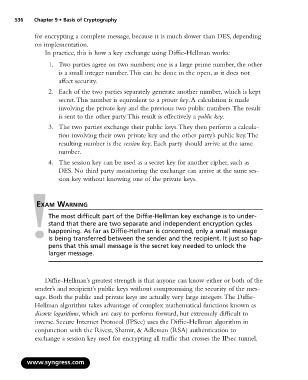Page 552 - StudyBook.pdf
P. 552
536 Chapter 9 • Basis of Cryptography
for encrypting a complete message, because it is much slower than DES, depending
on implementation.
In practice, this is how a key exchange using Diffie-Hellman works:
1. Two parties agree on two numbers; one is a large prime number, the other
is a small integer number.This can be done in the open, as it does not
affect security.
2. Each of the two parties separately generate another number, which is kept
secret.This number is equivalent to a private key.A calculation is made
involving the private key and the previous two public numbers.The result
is sent to the other party.This result is effectively a public key.
3. The two parties exchange their public keys.They then perform a calcula-
tion involving their own private key and the other party’s public key.The
resulting number is the session key. Each party should arrive at the same
number.
4. The session key can be used as a secret key for another cipher, such as
DES. No third party monitoring the exchange can arrive at the same ses-
sion key without knowing one of the private keys.
EXAM WARNING
The most difficult part of the Diffie-Hellman key exchange is to under-
stand that there are two separate and independent encryption cycles
happening. As far as Diffie-Hellman is concerned, only a small message
is being transferred between the sender and the recipient. It just so hap-
pens that this small message is the secret key needed to unlock the
larger message.
Diffie-Hellman’s greatest strength is that anyone can know either or both of the
sender’s and recipient’s public keys without compromising the security of the mes-
sage. Both the public and private keys are actually very large integers.The Diffie-
Hellman algorithm takes advantage of complex mathematical functions known as
discrete logarithms, which are easy to perform forward, but extremely difficult to
inverse. Secure Internet Protocol (IPSec) uses the Diffie-Hellman algorithm in
conjunction with the Rivest, Shamir, & Adleman (RSA) authentication to
exchange a session key used for encrypting all traffic that crosses the IPsec tunnel.
www.syngress.com

